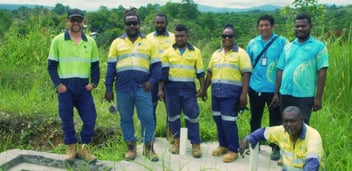Integrating climate adaptation into managing business-wide environment risk

As pressure to mitigate and adapt to climate change mounts across the water sector, one rural corporation has taken an innovative approach to restructuring its Environmental Management System (EMS) framework to incorporate key climate objectives across the business.
Set to present at Ozwater’24 on how Southern Rural Water’s (SRW) new EMS framework will help the water corporation accelerate climate change action, Environmental Advisor Catherine Corkill said that, traditionally, EMSs and climate change strategies have been managed separately.
“In its simplest form, an EMS is a framework that any business can use to manage environmental risks that come from business activities, which for us ranges from our office activities to managing our reservoirs and dam walls,” she said.
“What’s really great about our EMS framework is it helps to identify where we can enhance environmental performance, and ensures a life-cycle perspective and continual improvement when managing environmental risk.
“In comparison, climate change adaptation and mitigation strategies usually have very specific targets around emissions reductions and other ways to adapt. They are quite specific in their purpose. Until now, we’ve managed these two management plans separately.”
Corkill said SRW’s journey to restructuring its EMS to include its climate change strategy is an acknowledgement that it’s no longer possible to consider those two plans in silos anymore.
“From our perspective, robust environmental management is now intrinsically linked to climate change adaptation and mitigation,” she said.
“The environmental risks we manage, and any environmental conditions that might impact the business, are exacerbated in some form by climate change projections.
“For instance, we manage algal blooms in our reservoirs, and those blooms are impacted by rising temperatures and water flows. Climate change projections indicate that we are facing rising temperatures and variable rainfall, and it's critical to consider how we will manage those blooms through a climate change lens.
“We foresee that using EMS framework to drive those climate change actions will make sure that we are planning ahead and finding the opportunities to be more resilient. We are managing a very precious natural resource, we have to make sure we’re being proactive.”
Opportunity to evolve
With various separate strategies to juggle, SRW saw an opportunity to embark on a more holistic approach to environment and climate change issues, Corkill said, and create a dynamic framework capable of going above and beyond base-line requirements.
“We transitioned away from an EMS that was operational, only considering our big environmental risks, and towards a much more strategic approach, where we align our EMS to the direction of our entire business,” she said.
“We had an environmental strategy, our climate change plans and an EMS, all with objectives sitting within them. We wanted to bring it all together under one umbrella and manage it from a holistic perspective.
“We have included a target under our EMS to report on Scope 3 emissions, which isn’t something we have to do right now, but it is preparing us for the future and ensuring that we are becoming more resilient, and sooner.”
At the beginning of the process, SRW did some significant foundational work to set itself up for success, Corkill said.
“We wanted to revitalise and modernise our EMS and that started by changing our team name from the Environment team to Environment and Climate Change Adaptation team,” she said.
“We changed our environmental policy to an integrated environment climate change policy with really ambitious objectives. We looked at the EMS framework and started to incorporate climate change adaptation and mitigation throughout core processes.
“All of this was underpinned by work we did to build a strong governance structure, which has been key to keeping us on track. We developed an Environment and Climate Adaptation Committee that has representation from across the business.”
By bringing together SRW’s climate change plans and incorporating them into the EMS, the organisation is adding extra drive towards meeting its adaptation and mitigation goals.
“We had board support for this to be our main driver. We pulled objectives out of those climate plans and put them in the EMS to give them more leverage across the business. It’s creating a big push to help accelerate our actions towards meeting these challenges,” Corkill said.
Power in numbers
Corkill said establishing the Environment and Climate Adaptation Committee has been an important step in ensuring the EMS and embedded climate change adaptation targets are being focused on right across the business.
“The Committee comes together to talk about objectives, targets and how to implement them, as well as emerging risks, reporting up the chain to the executive level,” she said.
“We focused on embedding the EMS across the whole organisation. We placed our EMS objectives and targets into our corporate plan, our strategic asset management plan, and into water resource planning.
“This means it is not just the Environment and Climate Change Adaptation team that is doing this work, it’s happening right across the whole business.”
Corkill said having top-tier support for the new EMS was critical to the success of the work, but also to ensure all employees are empowered to have input, too.
“Having the support of our Board of Directors and the executive leadership team from the get-go has been crucial to the success of the process. They have been with us every step of the way, making sure we are aligning with the strategic vision of SRW,” she said.
“It’s been really fantastic having their support from the start. To any other organisation about to set out on a similar journey, I would suggest going straight to the top first. Leadership support is key.
“We wanted to ensure early engagement from across the business to secure that top-down, bottom-up work that needs to occur. We conducted workshops with different parts of the organisation, which really cemented engagement and participation from everyone.
“We are trying to solidify the notion that this is a team effort. Environment and climate change management is part of everyone’s work at SRW. We need everyone’s support and involvement.
“Bringing everyone along on the journey with us has been fun and exciting, and has empowered everyone in the business to have input on this journey as well.”
Interested in hearing more about Southern Rural Water’s new approach to its EMS?
Register for Ozwater’24 here.


